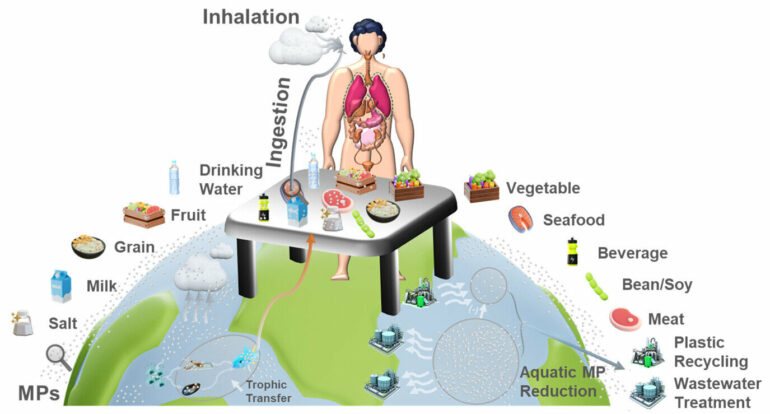Southeast Asian countries such as Indonesia, Malaysia and the Philippines top the global per capita list of dietary uptakes of microplastics, while China, Mongolia and the United Kingdom top the list of countries that breathe the most microplastics, according to a new study by Cornell researchers mapping microplastic uptake across 109 countries.
The study, published April 24 in the journal Environmental Science & Technology, builds on existing data models estimating how much microplastic humans unwittingly eat and inhale as a result of untreated plastic debris degrading and dispersing into the environment.
To more comprehensively estimate human consumption, the Cornell study accounts for each country’s eating habits, food processing technologies, age demographics and breathing rates—all factors that contribute to differences in how residents of each country consume microplastics.
“The uptake of microplastics at the country level is a critical indicator of plastic pollution and public health risks,” said Fengqi You, the Roxanne E. and Michael J. Zak Professor in Energy Systems Engineering, who co-authored the study with doctoral student Xiang Zhao. “Comprehensive global mapping supports local pollution mitigation efforts through enhanced water quality control and effective waste recycling.”
The study assesses dietary uptake by compiling data on microplastic concentrations in subcategories of major food groups such as fruits, vegetables, proteins, grains, dairy, drinks, sugars, salt and spices. The models also use data detailing how much of those foods are consumed in different countries. For instance, table salt consumption, per capita, is about equal in Indonesia and the U.S., but the microplastic concentration in Indonesian table salt is around 100 times higher.
Overall, the study found that Indonesians eat about 15 grams of microplastics per month—more than any other country—with the majority of plastic particles coming from aquatic sources such as seafood. That is a 59-fold increase in daily microplastic consumption from 1990 to 2018, the date range used for the models. U.S. dietary intake of microplastics is estimated to be about 2.4 grams per month, while the lowest is Paraguay at 0.85 grams.

Per capita daily MP dietary and inhalation uptake rates at the country level in 109 industrialized and developing countries within Asia, Europe, Africa, and North and South America, focusing on the world’s major coastlines that are affected by plastic pollution. © Environmental Science & Technology (2024). DOI: 10.1021/acs.est.4c00010
Data on airborne microplastic concentration, age demographics and human respiration rates were used to calculate microplastics being inhaled. Residents of China and Mongolia topped the list, breathing in more than 2.8 million particles per month. U.S. residents inhale about 300,000 particles per month. Only residents in the Mediterranean and nearby regions breathed less, with countries like Spain, Portugal and Hungary breathing about 60,000 to 240,000 particles per month.
“Industrialization in developing economies, particularly in East and South Asia, has led to increased consumption of plastic materials, waste generation and human microplastic uptake. Conversely, industrialized countries are experiencing a reverse trend, supported by greater economic resources to reduce and remove free plastic debris,” said You, who is a senior faculty fellow at the Cornell Atkinson Center for Sustainability.
You added that the study can inform reduction strategies for microplastic uptake that are tailored to local economies and industrial contexts, but that such efforts require international collaboration, such as technology support from developed countries to advance waste reduction strategies.
According to the study, a 90% reduction in aquatic plastic debris could lead to substantial decreases in microplastic exposure, potentially by up to 51% in developed countries and 49% in highly industrializing regions.
The study was published on the heels of an April 23–29 meeting of an international committee negotiating the U.N. Plastics Treaty, a legally binding agreement that would establish global rules around plastic production and disposal. The agreement is expected to be finalized later this year, with a focus on international collaboration to reduce microplastics in marine environments.
“Cleaning the global surface water system is a marathon influenced by local industrial and socioeconomic settings,” Zhao said. “However, our global map that pinpoints aquatic microplastic hotspots can initiate this journey, and our study highlights that addressing microplastic uptake requires a multifaceted approach, including sustainable packaging solutions, enforcing stringent waste management regulations and advancing water treatment technologies.”
More information:
Xiang Zhao et al, Microplastic Human Dietary Uptake from 1990 to 2018 Grew across 109 Major Developing and Industrialized Countries but Can Be Halved by Plastic Debris Removal, Environmental Science & Technology (2024). DOI: 10.1021/acs.est.4c00010
Provided by
Cornell University
Citation:
Study maps human uptake of microplastics across 109 countries (2024, May 22)



